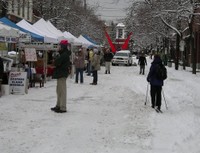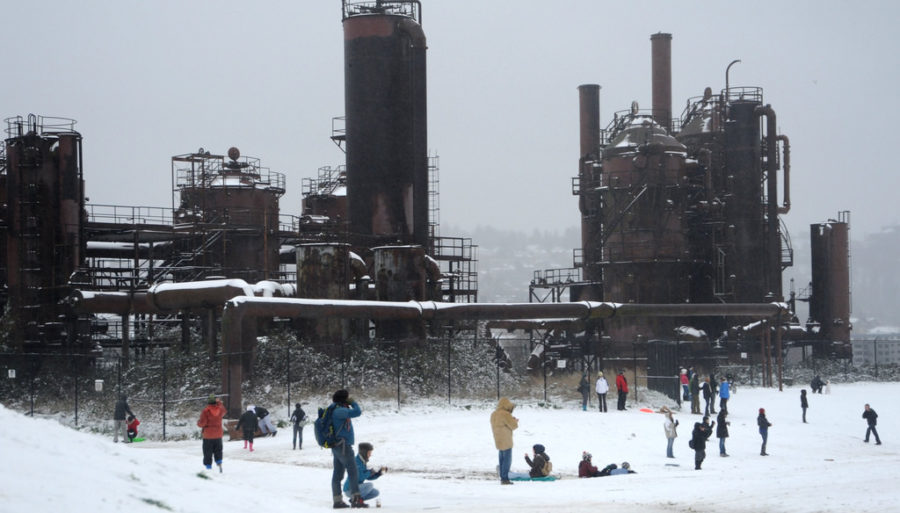Do “snow days” increase social capital—the strength of ties to friends, family, and community? That’s something I’ve been wondering about the past few days, while hearing all kinds of serendipitous Seattle snow encounter stories.
 Some are commute related: A stranded co-worker who was picked up at a bus stop on Aurora by a spur-of-the-moment carpooler headed downtown, and ended up having all kinds of connections with the other casual car-poolers; another coworker who, frustrated with the long wait at a Ballard bus stop, stuck out his thumb and was soon picked up by an SUV headed downtown. (His conclusion: Snow makes hitchhiking acceptable.)
Some are commute related: A stranded co-worker who was picked up at a bus stop on Aurora by a spur-of-the-moment carpooler headed downtown, and ended up having all kinds of connections with the other casual car-poolers; another coworker who, frustrated with the long wait at a Ballard bus stop, stuck out his thumb and was soon picked up by an SUV headed downtown. (His conclusion: Snow makes hitchhiking acceptable.)
 Some are neighborhood-related: Yesterday, my husband and I cross-country skied out our door onto what’s normally an arterial, then through several neighborhoods, meeting more people in an hour of city skiing than we had in a year of living here. A West Seattle colleague says she’s never had so much interaction with neighbors before—ten neighbors and eight dogs ended up at an impromptu sledding party in front of their house.
Some are neighborhood-related: Yesterday, my husband and I cross-country skied out our door onto what’s normally an arterial, then through several neighborhoods, meeting more people in an hour of city skiing than we had in a year of living here. A West Seattle colleague says she’s never had so much interaction with neighbors before—ten neighbors and eight dogs ended up at an impromptu sledding party in front of their house.
Not surprisingly, if you Google “snow and social capital,” you don’t find much, though it does bring up a page on 150 ways to build community. Tool lending libraries for things like snow blowers are one of the ways.
So in absence of solid academic research but in presence of numerous anecdotes, here’s my two-part hypothesis on snow and social capital.
1. First, a snow day does increase social capital, especially if it occurs as a not-quite-disastrous but still localizing event. Egh, there aren’t severe power outages, and people can drive if they really, really wanted to but the incentive is strong to stay in the neighborhood and try other forms of transport, such as sledding, skiing, walking, and transit.
In addition, snow dramatically reshapes the landscape to one where pedestrians literally rule the roads—the boundaries between road and sidewalk are blurred and the critical mass, for once, is walkers (plus some sledders and skiers). (See Hugeasscity‘s take on how snow helps people rediscover their legs.) This makes for a situation where you have all kinds of casual interactions with community members, which are exactly the kind that build social capital over time.
And because in a place like western Washington, this much snowfall is such an unusual, shared event, you automatically have a conversation starter for those interactions. People are snowboarding in the streets! Even normal encounters like going to the grocery have gone up a notch on the social capital scale. Folks take a little more time to ask their cashier how they’re doing and to appreciate that they made it into work.
Perhaps it makes our communities a bit more like a “slow town.”
2. On the flip side, snow also exposes flaws in the social-capital potential of your neighborhood. So while snow days make feet (and skis) a more viable form of transport, it can also exacerbate your neighborhood’s “unwalkability.” My husband’s parents, for example, are in their 70s and live in a house on a steep hill in Portland, Oregon, several miles from any kind of store. They were house-bound for a week before they finally convinced a taxi to come anywhere near their house. And they, of course, can afford a taxi. What about the folks who can’t?
 As for us, our neighborhood is fairly bus-able and (mostly) bikeable, but it’s at least a mile walk to any kind of grocery store or basic services. Not that’s it been a problem—we’ve been enjoying walking for our food for a few days now. But if we were older, less able, or lived a bit farther out, it would be a different story. Snow can also expose flaws in infrastructure priorities, as Bus Chick points out in her post on the icy-sidewalk issue.
As for us, our neighborhood is fairly bus-able and (mostly) bikeable, but it’s at least a mile walk to any kind of grocery store or basic services. Not that’s it been a problem—we’ve been enjoying walking for our food for a few days now. But if we were older, less able, or lived a bit farther out, it would be a different story. Snow can also expose flaws in infrastructure priorities, as Bus Chick points out in her post on the icy-sidewalk issue.
It’s interesting to consider how this all plays out in a true disaster situation, where we not only can’t go far but are without power, heat, etc. My hunch is that that’s when we really capitalize on the social capital that’s been built over time. (My new goal is to start investing now.)
Those are my theories—based on several days of un-scientific observation. What are yours?
P.S. Check out this photo–what might be the best illustration of this phenomenon that I’ve seen.
P.P.S. It’s also intriguing to think about other unusual, shared events that have upped the social capital quotient. A certain recent historic election comes to mind. So does the Red Sox winning the World Series. And so on. But it’s hard to beat snow for the local angle.
Photo credit: First photo (of Ballard farmers market) by Eric de Place; others by me.


Comments are closed.